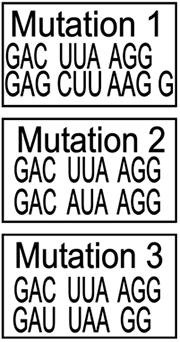
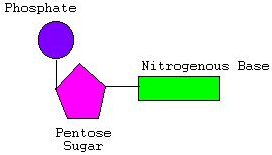
The picture above shows the monomer for deoxyribonucleic acid. What is the name of this monomer?
A. Nucleic acid
Incorrect. This is a small part of a nucleic acid.
B. Nucleus
Incorrect. The nucleus is where deoxyribonucleic acid is found within a cell.
C. Nucleolus
Incorrect. The nucleolus is found within the nucleus of a cell.
D. Nucleotide
Correct!
Of the three parts of a DNA nucleotide, which part determines the outcome of traits for an individual?
A. Phosphate-sugar backbone
Incorrect. The sugar-phosphate backbone is the same in all organisms.
B. Sequence of bases
Correct!
C. Both A and B
Incorrect. The sugar-phosphate backbone is the same in all organisms.
D. None of the above
Incorrect. There is a single correct answer.
A segment of nucleic acid is analyzed in a lab to see whether it is DNA or RNA. Lab technicians can determine whether a sample is composed of DNA if it contains —
A. deoxyribose sugar
Correct!
B. phosphate groups
Incorrect. Both DNA and RNA have phosphate groups.
C. hydrogen bonds
Incorrect. Both DNA and RNA have hydrogen bonds.
D. nucleotide bases
Incorrect. Both DNA and RNA have nucleotide bases.
Erwin Chargaff studied the DNA of organisms. In each of the species of organisms, which he studied, Chargaff discovered that the amount of adenine is about equal to the amount of thymine. Which of these explains why the ratio of adenine to thymine is the same?
A. Adenine and thymine pair with each other.
Correct!
B. Adenine binds with nitrogen oxide, while thymine binds with nitrates.
Incorrect. Adenine binds with thymine only.
C. Adenine and thymine have the same amount of hydrogen.
Incorrect. Hydrogen does not explain why there are equal amounts of adenine and thymine.
D. Adenine bases contain a form of thymine.
Incorrect. Adenine and thymine are both nitrogenous bases found in DNA. One cannot contain the other.
Which of the following substances is responsible for storing information that can determine the traits carried and expressed by an individual?
A. Pentose sugar
Incorrect. A pentose sugar is only part of the molecule.
B. Phenotype
Incorrect. A phenotype is what the expressed trait looks like on an individual.
C. Nucleus
Incorrect. A nucleus is the location of the substance, not the name of the substance.
D. Deoxyribonucleic acid
Correct!
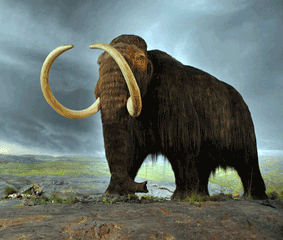
Scientists have been able to extract the DNA from the extinct wooly mammoths found on Wrangle Island in the Atlantic Ocean. If the DNA sequence found contained the nitrogenous base sequence below, what could scientists conclude that the complimentary strand consists of?

A. GCAATTAGCACCC
Incorrect. This is the same as the original strand.
B. CGUUAAUCGUGGG
Incorrect. This is the mRNA strand, not the complimentary DNA strand.
C. CGTTAATCGTGGG
Correct!
D. GCTTAAACGTGGG
Incorrect. The base pairings are not correct.
If all new cells arise from an existing cell, why isn’t the DNA in every cell exactly identical?
A. Cells make new, unique DNA every time they replicate.
Incorrect. The DNA in new cells is almost the same as the parent cell.
B. Mutations within DNA can cause slight differences in its sequence.
Correct!
C. DNA only changes when an organism is young.
Incorrect. DNA does not change over the lifespan of an individual.
D. DNA is only found in one cell in the body.
Incorrect. Every cell in the body contains DNA.
Mutations affect a cell by —
A. allowing the nucleus to divide
Incorrect. The nucleus does not divide.
B. changing the sugar-phosphate backbone of DNA
Incorrect. The sugar-phosphate backbone remains unchanged.
C. influencing which DNA will change into RNA
Incorrect. DNA cannot change into RNA.
D. changing the amino acids that are produced
Correct!
Which type of mutation has occurred in the following sequence?

A. Insertion
Incorrect. Only one triplet was affected.
B. Deletion
Incorrect. Only one triplet was affected.
C. Substitution
Correct!
D. None of the above
Incorrect. There is a correct answer.
Of the three mutations shown below, which one is likely to be the least harmful?

A. Mutation 1
Incorrect. Insertion mutations can affect an entire polypeptide chain of amino acids.
B. Mutation 2
Correct!
C. Mutation 3
Incorrect. Deletion mutations can affect an entire polypeptide chain of amino acids.
D. They are all equally harmful.
Incorrect. Two of the mutations affect more amino acids than the other.
A woman was diagnosed with lung cancer while she was pregnant with her first child. What are the chances that her baby will be born with lung cancer?
A. 0 percent. The mutation that caused lung cancer was not present in the gamete cells and cannot be passed to the baby.
Correct!
B. 25 percent. In some cases, the mutation will be passed from the somatic cells to the gametes.
Incorrect. Somatic cells cannot pass cancer to the offspring.
C. 50 percent. There is random chance as to whether or not the mutation will be passed down through the somatic cells.
Incorrect. Somatic cells cannot pass cancer to the offspring.
D. 100 percent. The mutation is always passed down from the mother to offspring through somatic lung cells.
Incorrect. Somatic cells cannot pass cancer to the offspring.
Insertion and deletion mutations can be more harmful than substitution mutations because –
A. they contain more mutations
Incorrect. A single mutation can cause major disruptions in protein development.
B. they affect carbohydrate chains that come before the mutation
Incorrect. Carbohydrate chains are not directly affected by mutations. Mutations affect proteins.
C. they affect all amino acids following the mutation
Correct!
D. they do not affect amino acids
Incorrect. Since the DNA code is used to make proteins, mutations affect the sequence of amino acids that make the proteins.
Mike and Amy had a child born with the genetic disease cystic fibrosis. Both Mike and Amy were normal, showing no signs of this disorder. How is it possible for them to have a child with this disease?
A. Cystic fibrosis must be a dominant trait disorder hidden in both parent’s genotype.
Incorrect. Dominant traits are not hidden. Mike and Amy would both have had cystic fibrosis in this case.
B. Cystic fibrosis must be a recessive trait disorder hidden in both parent’s genotype.
Correct!
C. Cystic fibrosis must be a dominant trait disorder hidden in one parent’s genotype.
Incorrect. Dominant traits are not hidden. Mike or Amy would have had cystic fibrosis in this case.
D. Cystic fibrosis must be a recessive trait disorder hidden in one parent’s genotype.
Incorrect. Both parents must possess the hidden trait in order to have a child with cystic fibrosis.
In pea plants, purple flowers (P) are dominant to white flowers (p). A purple pea plant is crossed with a white pea plant. 237 purple plants and 231 white plants are produced from the seeds of the F1 generation. What is the genotype of the parent plants?
A. PP×Pp
Incorrect. Draw a Punnet Square and try again.
B. Pp×pp
Correct!
C. Pp×Pp
Incorrect. Draw a Punnet Square and try again.
D. pp×pp
Incorrect. Draw a Punnet Square and try again.
In mice, black spots are dominant to tan spots and long tails are dominant to short tails. A female mouse is heterozygous for black spots and homozygous for short tails. She will mate with a male mouse that is homozygous recessive with tan spots and heterozygous for long tails. What would the possible genotypes of the offspring be?
A. BbLL, BbLl, bbLL, bbLl
Correct!
B. BBll, BBLl, bbLL, bbll
Incorrect. Draw a Punnet Square and try again.
C. BbLL, BBLL, bbLL, bbee
Incorrect. Draw a Punnet Square and try again.
D. BbLL, bbLl
Incorrect. Draw a Punnet Square and try again.
A man with type O blood marries a woman with type AB blood. What is the probability that they will have a child with type A blood?
A. 0 percent
Incorrect. Draw a Punnet Square and try again.
B. 25 percent
Incorrect. Draw a Punnet Square and try again.
C. 50
Correct!
D. 100 percent
Incorrect. Draw a Punnet Square and try again.
A number of plant species have a recessive allele for albinism; homozygous albino individuals are unable to synthesize chlorophyll. If a heterozygous tobacco plant is crossed with another heterozygous plant and 400 of its seeds germinate, how many seedlings will be expected to be albino?
A. 100
Correct!
B. 200
Incorrect. Draw a Punnet Square and try again.
C. 300
Incorrect. Draw a Punnet Square and try again.
D. 400
Incorrect. Draw a Punnet Square and try again.
The four o’clock plant exhibits incomplete dominance. Homozygous dominant plants have red flowers, homozygous recessive plants have white flowers, and heterozygous plants have pink flowers. If a red-flowered parent plant has all pink-flowered offspring, what genotype does the other parent plant have?
A. RR
Incorrect. Draw a Punnet Square and try again.
B. Rr
Incorrect. Draw a Punnet Square and try again.
C. rr
Correct!
D. None of these
Incorrect. Draw a Punnet Square and try again.
What do phytoplankton, E. coli bacteria and humans have in common with each other?
A. They both lack amino acids.
Incorrect. They both are made of proteins and therefore contain amino acids.
B. They both are made of only proteins and lipids.
Incorrect. They both all made of the four macromolecules; carbohydrates, nucleic acids, proteins, and lipids.
C. They both are found in freshwater and saltwater habitats.
Incorrect. Humans do not live in an aquatic habitat.
D. They both have similar DNA containing the same four nitrogen bases.
Correct!
All organisms on the planet have similar DNA. One difference in their DNA is –
A. the sugar-phosphate backbone
Incorrect. The sugar-phosphate backbone is common to all organisms.
B. the size of the nitrogen bases
Incorrect. The nitrogen bases are the same in all organisms.
C. the sequence of the nitrogen base pairs
Correct!
D. the sequence of the sugar-phosphate backbone
Incorrect. The sugar-phosphate backbone is the same in all organisms.
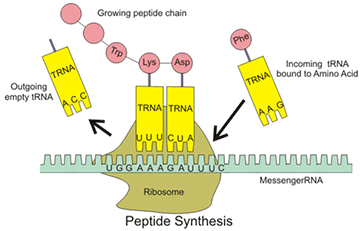
The process above shows the transfer of RNA bringing amino acids to a ribosome where they are assembled into a polypeptide chain. This process shown in the diagram is the —
A. transcription of DNA to RNA
Incorrect. There is no DNA involved in this step of protein synthesis.
B. translation of mRNA code into protein
Correct!
C. replication of DNA
Incorrect. There is no DNA involved in this step of protein synthesis.
D. cellular respiration and the production of energy molecules
Incorrect. Cellular respiration takes place in the mitochondria, not the ribosome.
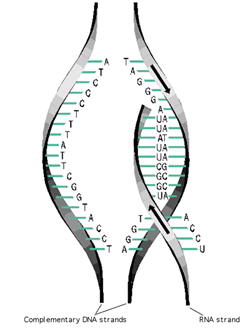
The diagram above shows a process, which ultimately leads to the production of a protein. The above process must occur before translation into protein can take place. It takes place in the nucleus of the cell. What is happening in the above diagram?
A. DNA is replicating
Incorrect. When DNA replicates, both strands of the DNA are transcribed.
B. Transcription of the DNA code by mRNA
Correct!
C. Sugars are being produced
Incorrect. Sugars are not produced by DNA.
D. DNA is copying tRNA to use in creating amino acids
Incorrect. tRNA is used in the translation step which takes place at the ribosome, not the nucleus.
If all DNA within cells is the same sequence, why are muscle cells different than nerve cells?
A. Some genes are expressed while others are turned off
Correct!
B. Some DNA has genes while some does not
Incorrect. Segments of DNA are called genes.
C. Genes do not determine how the cell will function
Incorrect. Genes are segments of DNA and many determine the cell’s functions.
D. Nerve cells do not need DNA
Incorrect. Nerve cells contain DNA.
Genes are turned off and on in cells as needed to perform specific functions. For example, genes that are expressed to create the hormone estrogen will not be turned on until a female reaches puberty. This regulated process in which DNA is translated into proteins is known as –
A. gene communication
Incorrect. Gene communication is not a process carried out by genes.
B. gene differentiation
Incorrect. Gene differentiation is not a process carried out by genes.
C. gene expression
Correct!
D. gene creation
Incorrect. Gene creation is not a process carried out by genes.
Which of the following best explains the importance of meiosis to genetic variation?
A. Meiosis allows all cells to be identical to the parent cell.
Incorrect. The daughter cells that are created by meiosis are genetically different than the parent cells.
B. Meiosis allows a greater number of genetic combinations to be available to gametes.
Correct!
C. Meiosis creates two cells that are genetically identical.
Incorrect. Meiosis creates four cells that are genetically different.
D. Meiosis is not important to genetic variation.
Incorrect. Meiosis is what allows genetic variation to exist.
The products of meiosis are —
A. two genetically identical cells
Incorrect. This describes the products of mitosis.
B. four genetically identical cells
Incorrect. Meiosis creates four cells that are genetically different.
C. two genetically different cells
Incorrect. Meiosis creates four cells that are genetically different.
D. four genetically different cells
Correct!
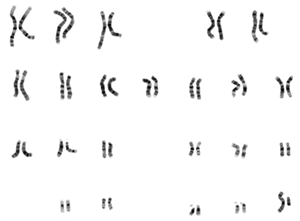
If future parents are concerned about the health of their unborn child, they can choose to perform a chromosome analysis that will give them information about certain genetic disorders such as Down syndrome. This analysis is a picture of the child’s chromosomes and is called a —
A. karyotype
Correct!
B. chromosome
Incorrect. There are chromosomes in the picture but the question is asking about the picture as a whole.
C. nondisjunction
Incorrect. While nondisjunction can be seen in a picture like this, the question is asking for the name of this analysis.
D. crossing over
Incorrect. Crossing over takes place during meiosis and is not the name of chromosomal analysis.
Everyone has unique DNA that is different from anyone else on the planet. Lab techniques can be used to compare DNA found at a crime scene to a suspect’s DNA. Similarities and differences can convict someone of a crime. This technique is called —
A. DNA Fingerprinting
Correct!
B. karyotyping
Incorrect. Karyotyping is a chromosomal analysis that can show nondisjunction disorders.
C. DNA Transcription
Incorrect. Transcription is the first step of protein synthesis.
D. gene expression
Incorrect. Gene expression is a regulated process that turns genes on or off.
The series "Thymine—adenine—thymine—cytosine--guanine" appeared in the nucleus of a deer cell. This series describes —
A. nucleotides of mRNA
Incorrect. RNA does not contain thymine.
B. the location of the covalent bonds
Incorrect. This does not describe covalent bonds.
C. the sugar-phosphate backbone
Incorrect. The series listed are the base pairs found in DNA.
D. nitrogen bases in a segment of DNA
Correct!
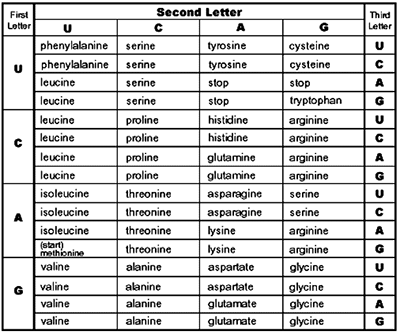
An organism contains a section of DNA shown below. What is the sequence of amino acids that are expressed from this strand?

A. Proline-Leucine-Methionine-Alanine
Incorrect. Make sure you are using the corresponding mRNA strand and try again.
B. Leucine-Asparagine-Methionine-Proline
Incorrect. Make sure you are using the corresponding mRNA strand and try again.
C. Histidine-Leucine-Tyrosine-Glycine
Correct!
D. Lysine-Valine-Tyrosine-Proline
Incorrect. Make sure you are using the corresponding mRNA strand and try again.